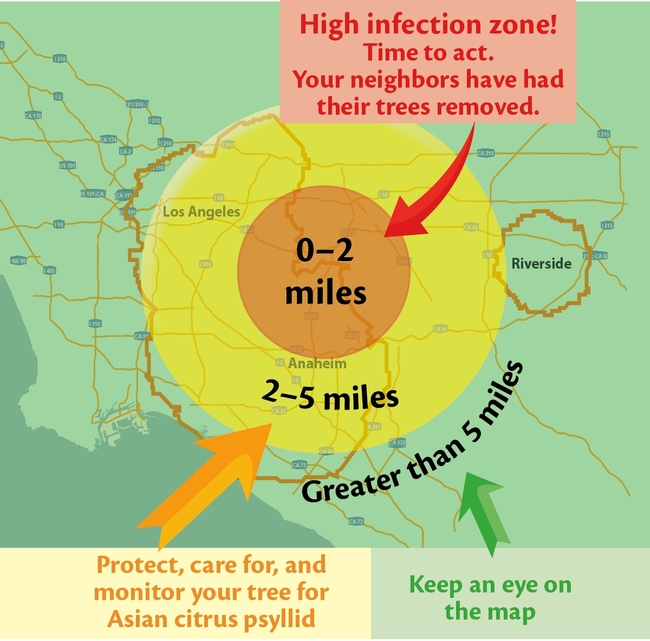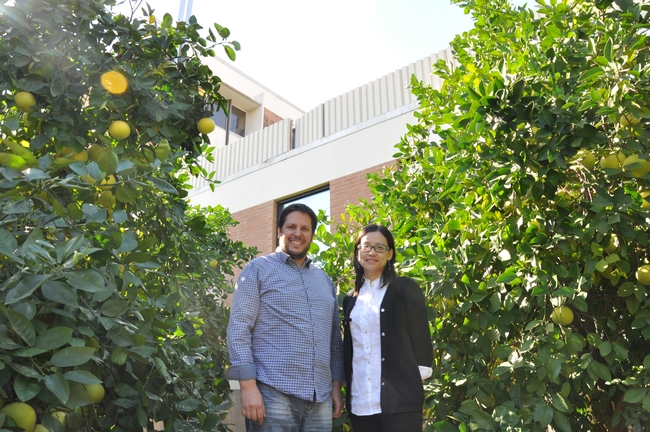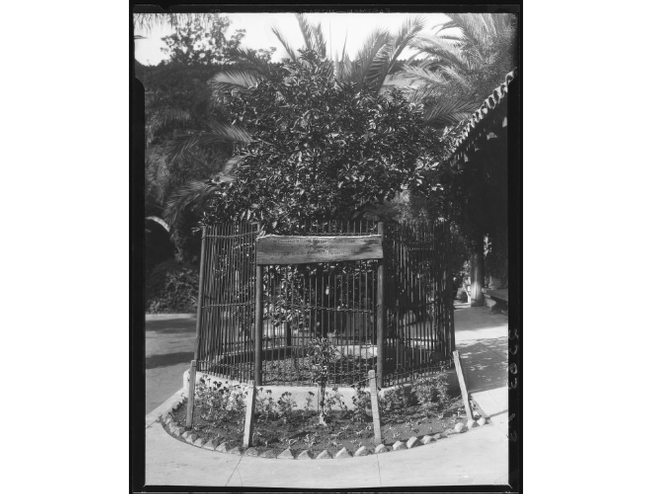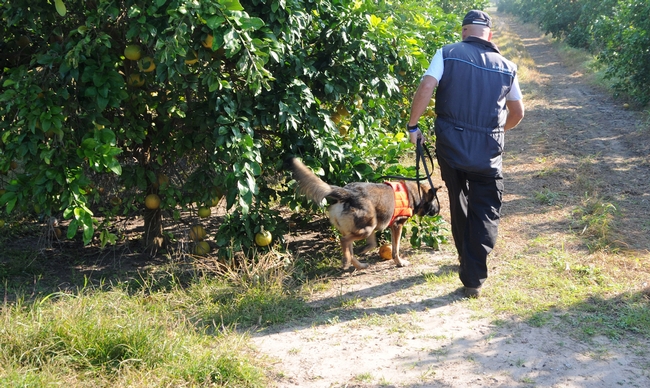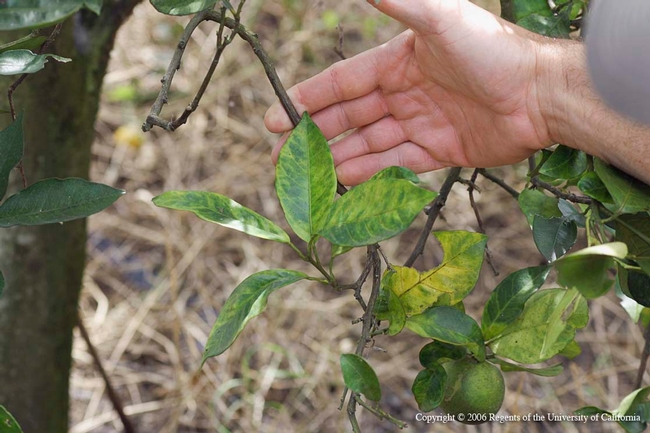
Posts Tagged: huanglongbing
Consult UC ANR's map to see how close you live to citrus with HLB disease
UC Cooperative Extension developed an online interactive map that allows Californians to see how close they live to citrus trees infected with huanglongbing disease, reported Jeanette Marantos in the Los Angeles Times. This information is critical for the more than 60% of Californians who are growing their own backyard orange, grapefruit, mandarin, lime and other citrus trees.
Huanglongbing is an exotic citrus disease that kills every tree it infects. An exotic insect, the Asian citrus psyllid, spreads the disease from tree to tree. If the disease makes its way into California's commercial citrus production regions, it threatens the state's valuable and iconic citrus industry.
Go to http://ucanr.edu/hlbapp and type in your address. If you are inside the red circle — within two miles of a hot zone — UCCE suggests you remove your citrus trees and plant different types of fruit trees, such as peaches, pears, apples or figs, until researchers find a cure. In the yellow circle — within two to five miles of a hot zone — consider replacing your tree with a non-citrus fruit tree or protect your citrus trees. Find detailed information on home citrus management here https://ucanr.edu/sites/ACP/Homeowner_Options/
“When we first started this program back in 2012, I was encouraging Master Gardeners to teach homeowners how to treat their trees [to discourage psyllids, which are the insects that spread HLB],” she said, “but the complaint came back from the Master Gardeners, ‘I treat my trees but none of my neighbors do, so what's the point?'” said Beth Grafton-Cardwell, UC Cooperative Extension entomology specialist and director of the Lindcove Research and Extension Center in Exeter.
Grafton-Cardwell said the threat is serious. HLB disease devastated Florida's citrus industry when it hit in 2005, destroying half of its acreage and production, and pretty much eliminating residential citrus.
The battle against the psyllid in California is being helped by the introduction in 2011 of Tamarixia radiata, a parasitic wasp native to Pakistan, by UC Cooperative Extension biological control specialist Mark Hoddle and his entomologist wife Christina Hoddle.
"We've had psyllid here [in California] since 2008, but we still have a lot of oranges,” Hoddle said. “The disease hasn't swept through California the way it did through Florida, and I believe our biological control program is why. Psyllid populations have decreased by 70% to 80% since our first parasite release in 2011. We haven't wiped out HLB in citrus trees, but we have mitigated the risk.”
Screen installed over the 'parent navel' in Riverside to protect it from disease
City of Riverside staff draped a synthetic screen on a steel frame to encompass the 'parent navel' orange tree at the corner of Arlington and Magnolia avenues in Riverside to protect it from Asian citrus psyllids that spread huanglongbing disease, reported Ryan Hagen in the Riverside Press-Enterprise. Huanglongbing (HLB) is a devastating bacterial disease of citrus that is starting to spread rapidly in urban areas of Southern California.
The newly covered tree is valued for its status as an early ancestor of all Washington navel orange trees.
UC Cooperative Extension specialist Georgios Vidalakis, the UC Presidential Researcher for Sustainable Citrus Clonal Protection, was on site when the tree was enclosed within the new cover.
“This one will buy us a few years so the city can design a more elegant structure like you see in arboretums — maybe a wood hexagonal pavilion that will be aesthetically more pleasant,” Vidalakis said. “Unless in the next few years we find a solution.”
UC Agriculture and Natural Resources specialists and advisors are working with the citrus industry, USDA and CDFA to control ACP populations and keep HLB contained while researchers search for a cure for the disease.
Riverside Washington Navel gets additional protection
The city of Riverside is taking steps to protect a 143-year-old Washington Navel orange tree - the tree that parented most navel oranges alive today, reported the Riverside Press-Enterprise.
According to legend, the seedless and sweet Washington navel was an accidental mutant that appeared on the grounds of a Brazil monastery in the early 1800s. Tree clones were sent to USDA in Washington, D.C., and from there acquired by Eliza Tibbets, who tended the trees at her home in Riverside.
This month, city workers removed two trees that were planted near the iconic navel orange - a Marsh Grapefruit and another navel, which was planted in the 1940s and doesn't have the historical value. They have built a steel structure over the Washington Navel to support a transparent screen that will keep out Asian citrus psyllid, an invasive pest that spreads the devastating huanglongbing virus in citrus.
The measures to protect the tree were planned by a team that includes scientists from UC Riverside, the Citrus Research Board and the USDA, the article said.
For more information on the photo above, see visit this UCLA Library page.
Dogs enlisted to sniff out disease in citrus trees
The Citrus Research Board is arranging to bring specially trained dogs to the UC Lindcove Research and Extension Center to test their ability to sniff out the devastating citrus disease huanglongbing, reported Bob Rodriguez in the Fresno Bee.
CRB president Gary Schulz is working with the USDA, which is training dogs in Florida to identify trees with huanglongbing soon after the trees are infected. HLB has ravaged Florida's citrus industry. In California, the disease has been found about 800 Southern California backyard trees, but officials have so far managed to keep it out of the state's commercial orchards.
"The USDA has invested million of dollars in detector dogs and they have proven to be a credible diagnostic tool for early detection and screening trees," Schulz said.
HLB is spread by Asian citrus psyllids. Psyllids can pick up the the disease from infected trees and spread it to other trees as they feed. Symptoms may not show up in the tree until a year or two after it is infected. PCR (polymerase chain reaction) is the only way to positively identify huanglongbing infection in citrus. The process requires testing of many leaves or branches from the tree and may return a false negative if the samples selected for testing aren't infected, but other parts of the tree are.
Schulz said the HLB-detection dogs will start their California work in the southern part of the state before traveling north.
Pesticide spray ban could assist spread of huanglongbing disease
A Sacramento County Superior Court judge has ordered California agricultural officials to stop spraying pesticides in parks, schools and residents' backyards to control pests that threaten the ag industry, reported Gregory Mohan in the Los Angeles Times.
CDFA issued a statement saying it will consider appealing the case, and will continue to conduct spraying "in compliance with" state environmental laws.
Julia Mitric of Capital Public Radio spoke to UC Cooperative Extension entomology specialist Beth Grafton-Cardwell about the ruling. Grafton-Cardwell said it's a "huge setback."
She said spraying trees to control Asian citrus psyllid, which spreads the devastating huanglongbing disease of citrus, is crucial to buy time for scientists to develop long-term solutions to the threat.
"The state has managed to contain it to three counties in California — for the moment," Cardwell said. "But it's starting to spread very rapidly and so it's the most critical point in time to limit the psyllid spread."
